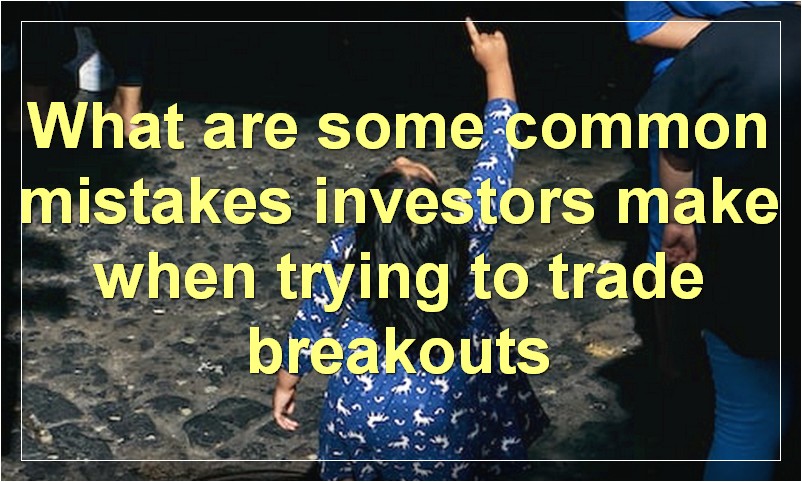When it comes to making money in the stock market, timing is everything. And one of the best ways to time the market is to find and trade breakout stocks.
What is a breakout
A breakout is a sudden, sharp increase in price or volume. Breakouts often occur after a period of consolidation, when prices have been moving sideways for some time. They can signal the start of a new trend, or simply be an anomaly.
There are two types of breakouts: false breakouts and true breakouts.
False breakouts occur when prices spike above or below a resistance or support level, but then quickly revert back inside the previous range. This can lure in traders who think the breakout is real, only to see them get trapped when prices move back down.
True breakouts occur when prices sustain a move above or below a resistance or support level. This is generally seen as a more reliable signal that a new trend may be forming.
What are some signs that a stock might be about to breakout

There are many signs that a stock might be about to breakout. The most common and reliable sign is when the stock price starts to move up consistently and steadily over a period of time. This can be accompanied by heavy volume trading, which indicates that there is high demand for the stock. Other signs include positive news announcements from the company, analyst upgrades, and insider buying. If you see one or more of these indicators, it could be a good idea to buy the stock before it breaks out and becomes even more expensive.
How can you identify potential breakout stocks
A breakout stock is a stock that is trading at a price that is significantly higher than its recent trading range. A breakout can occur for a variety of reasons, including positive earnings reports, analyst upgrades, or increased demand from institutional investors.
There are a few ways to identify potential breakout stocks. One way is to look for stocks that have been consolidating for a period of time and are starting to trade in a narrower range. This indicates that the stock is beginning to build up momentum and could make a move higher. Another way to identify potential breakout stocks is to look for stocks with rising volume. This indicates that more investors are interested in the stock and that it could be ready to make a move higher.
If you are looking for potential breakout stocks, it is important to do your own research and not rely solely on the opinion of others. Be sure to monitor the news and earnings reports for the companies you are interested in and be prepared to act quickly if a breakout does occur.
When is the best time to buy stocks that are about to breakout
If you’re looking to buy stocks that are about to breakout, the best time to do so is typically just before they start to rise. This way, you can get in on the action early and potentially make a profit as the stock price continues to increase. However, it’s important to do your research first and make sure that the stock is actually worth investing in. Otherwise, you could end up losing money instead of making a profit.
What is the difference between a breakout and a false breakout
A breakout is a price movement through an identified level of support or resistance. A false breakout is a price movement that fails to continue through an identified level of support or resistance and results in a reversal.
What are some common mistakes investors make when trying to trade breakouts

When it comes to trading breakouts, investors often make the same mistakes. Here are four common mistakes to avoid when trading breakouts:
1. Failing to Set a Stop Loss
One of the most common mistakes investors make when trading breakouts is failing to set a stop loss. A stop loss is an order that you place with your broker to sell your shares if the stock price falls below a certain price.
Without a stop loss in place, you could end up losing a lot of money if the stock price falls sharply after you buy it.
2. Buying Too Late
Another mistake investors make is buying the stock too late after the breakout occurs. Often, by the time a stock breaks out, it has already made most of its move and is ripe for a pullback.
If you wait too long to buy, you may miss out on the initial move and end up buying near the top.
3. Not Using Limit Orders
When you place an order with your broker to buy or sell shares, you can choose between a market order and a limit order. A market order will execute immediately at the current market price.
A limit order, on the other hand, will only execute at the price you specify. For example, if you place a limit order to buy shares of XYZ stock at $50 per share, your order will only fill if the stock trades at or below $50 per share.
Limit orders give you more control over your trade and can help you avoid paying too much for a stock. However, they also come with the risk of your order not filling at all if the stock price doesn’t reach your specified price.
4. Holding Onto Losing Positions for Too Long
Investors sometimes hold onto losing positions for too long, hoping that the stock will eventually rebound and turn into a winner. This is commonly referred to as “throwing good money after bad.”
It’s important to cut your losses when they occur and move on to other opportunities. Otherwise, you could end up losing a lot of money needlessly.
How can you protect yourself from false breakouts
There are a few things you can do to protect yourself from false breakouts. First, make sure you are using a clean pillowcase. Secondly, don’t touch your face with your hands. Lastly, use a oil-free moisturizer to keep your skin hydrated.
What are some strategies for trading breakouts
There are a few key strategies that traders use when trading breakouts. The first is to identify the level at which the breakout is likely to occur. This can be done by looking at support and resistance levels, or by using technical indicators such as Bollinger Bands.
Once the level is identified, traders will then wait for the price to break out and then enter their positions. It is important to note that not all breakouts will be successful, so it is crucial to use stop-loss orders to protect against losses.
Another strategy that can be used is to trade the false breakout. This occurs when the price breaks out of a level but then quickly reverses back into the range. This can be a profitable trade if timed correctly, but it is also very risky.
Finally, some traders choose to fade breakouts. This means they take a position in the opposite direction of the breakout. This can be a risky strategy, but it can also pay off if the breakout fails.
Can breakout stocks continue to rise after breaking out
When it comes to stocks, a breakout is typically defined as a price move above resistance or a key moving average. After a breakout, stocks will often continue to rise as investors pile into the name in an effort to capture profits. However, there are times when a stock will breakout and then quickly reverse course, leading to losses for investors. So, the question is, can breakout stocks continue to rise after breaking out?
The answer, unfortunately, is that there is no surefire way to know. However, there are a few things that investors can look for that may help indicate whether a stock is likely to continue higher after a breakout. First, it’s important to see strong volume accompany the breakout. This indicates that there is significant interest in the stock and that buyers are willing to step in and drive the price higher. Second, it’s also helpful to see the stock make a sustained move above the resistance level. This shows that the stock has momentum and is likely to continue moving higher. Finally, it’s also worth monitoring the overall market conditions. If the market is in a broad-based uptrend, then it’s more likely that a breakout stock will continue to move higher. However, if the market is struggling, then it’s less likely that a breakout stock will be able to sustain its gains.
So, while there’s no guaranteed way to know whether a breakout stock will continue to rise after breaking out, there are some things that investors can look for that may give them a better chance of success.
What are some factors that can cause a stock to breakout
When it comes to stocks, a breakout is when the price of a security moves outside of a defined trading range. This can be caused by a number of different factors, including earnings reports, analyst upgrades/downgrades, or even news events. When a stock breaks out, it can attract attention from other traders and investors, which can cause even more buying (and selling) pressure and potentially push the price even higher (or lower).

